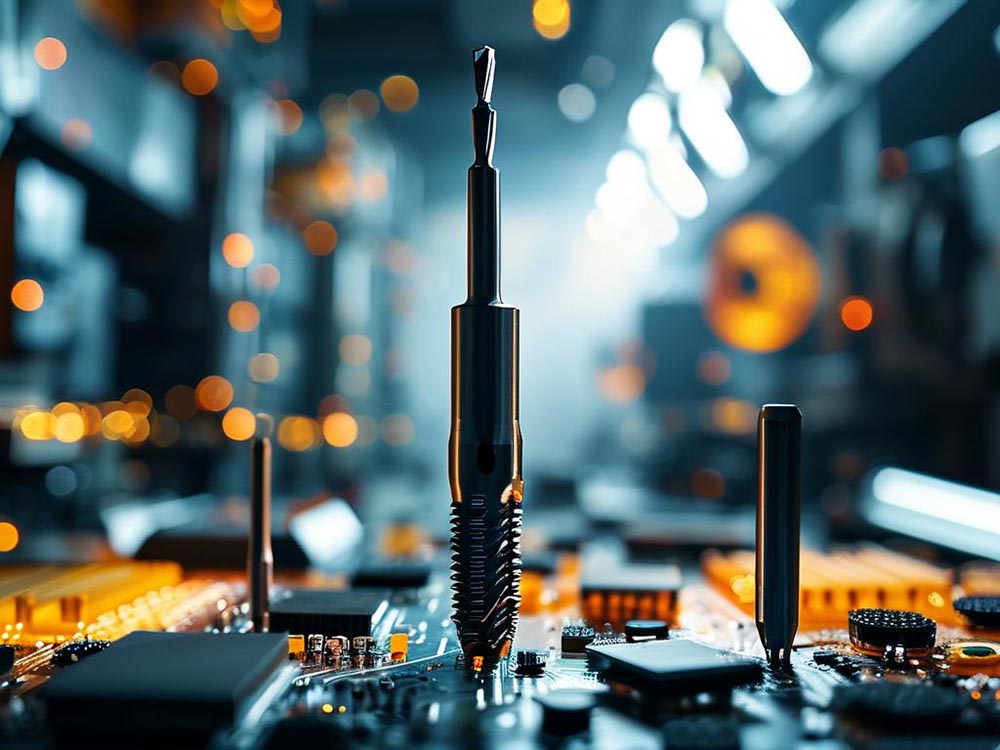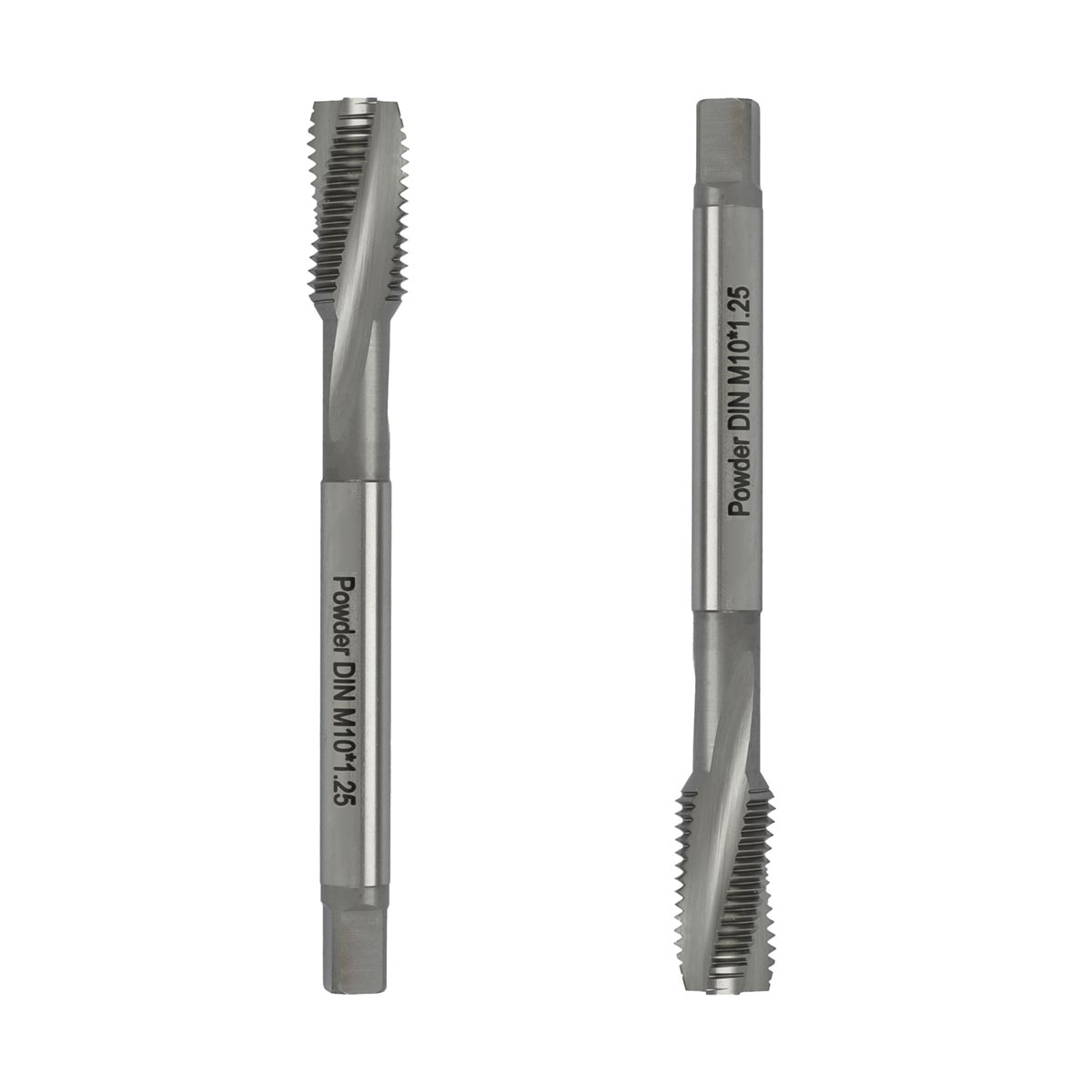Precision Machining Challenges in the Electronics Industry: HSSE & HSSE-PM Taps as the Game Changer
"A single smartphone requires over 200 micro screws to secure its precision components, and each screw hole must be machined with an accuracy of less than 0.02mm—about one-third the diameter of a human hair. As the electronics industry advances towards miniaturization, traditional cutting tools are facing unprecedented challenges..."
Unique Machining Challenges in the Electronics Industry
Increased Complexity of Materials
Comparison of material hardness and processing difficulties:
304 stainless steel shielding cases vs. titanium alloy medical device connectors vs. phosphor bronze contact components
Case Study:
A well-known smartwatch brand experienced mass production delays due to tap breakage while threading 316L stainless steel watch cases.
Challenges in Hybrid Material Machining
Thread synchronization challenges in composite structures:
Smartphone mid-frame: aluminum-magnesium alloy + stainless steel inserts (thermal expansion mismatch leading to thread failure).
Folding screen hinges: MIM (Metal Injection Molding) parts requiring post-sintering thread corrections (hardness fluctuation ±3 HRC).
The Limits of Micro-Scale Machining
Increasing proportion of micro threads (M0.8-M2) in the industry (2023 data).
Breakthrough in deep-thread machining for PCBs:
Achieving a 1:15 depth-to-diameter ratio as the new industry standard.
Physical Limits in Micro-Hole Machining
Torque load calculation for Ø0.5mm taps:
Fracture risk rises sharply when torque exceeds 0.05N·m.
Chip evacuation dynamics in ultra-deep blind holes (1:20 depth-to-diameter ratio):
Quantitative analysis of chip accumulation leading to taper errors in bore diameters.
Stability Challenges in Mass Production
Continuous operation for 24 hours:
Temperature variation analysis shows traditional HSS exhibits significant dimensional drift at 40°C.
Tool consistency in multi-spindle machines:
Cutting force deviation must be less than 5% across 8 synchronized spindles.
The Cost-Performance Dilemma
Case Study:
An ODM factory suffered a 23% increase in unit production costs due to insufficient tap lifespan.
HSSE-PM Taps: Innovations in Processing Technology
Advancements in Powder Metallurgy Technology
- 300% improvement in carbide distribution uniformity.
- Comparison of atomization powder processing parameters: D50 grain size = 45μm vs. traditional 60μm.
- Hot Isostatic Pressing (HIP) treatment reduces porosity: From 0.3% to 0.03%, as confirmed by metallographic analysis.
Cutting Edge Reinforcement Technologies
- Asymmetric land design: Suppresses cutting vibrations (FFT spectrum analysis).
- Nano-crystalline gradient coatings: 3μm-thick AlTiCrN coating with residual stress simulation.
Design Optimization for the Electronics Industry
- Optimized spiral flute angle: 35° vs. traditional 45° for enhanced chip evacuation.
- TiAlN coating reduces friction coefficient in aluminum alloy machining (experimental results).
Enhancements for Automated Production
- Runout control within 0.005mm for robotic system compatibility.
- Quick-change tool interface reduces downtime in production line transitions.
The Role of HSSE/HSSE-PM Taps in Electronics Manufacturing: Application Case Studies
Precision Components in Smartphones
Smartphone Mid-Frame Threading (Material: 6061 Aluminum Alloy / 316L Stainless Steel)
- Challenges:
Thin-walled aluminum frame (0.6mm thickness) prone to deformation; stainless steel frame causes tool adhesion.
- HSSE-PM Solution:
50° high-helix design + TiAlN coating improves aluminum chip evacuation by 40%.
Asymmetric land reinforcement reduces vibration, ensuring stainless steel surface roughness Ra0.4-0.6μm.
- Results:
A leading smartphone OEM achieved a good part yield increase from 95.2% to 99.8%, with tool life reaching 12,000 holes (compared to only 3,500 for conventional taps).
Folding Screen Hinge Micro Threads (Material: 17-4PH Stainless Steel, HRC 38-42)
- Challenges:
M0.8 threads with 8D depth (6.4mm) prone to tap breakage and thread pitch deviations.
- Innovations:
Powder metallurgy substrate: 3,800MPa flexural strength, reducing breakage rate by 90%.
Internal coolant channel (Ø0.3mm): Controls blind-hole machining temperature under 30°C.
- Industry Application:
A folding phone manufacturer used HSSE-PM-M0.8 taps with ±0.01mm thread pitch tolerance, tripling processing efficiency.
Core Components of 5G Communication Equipment
Base Station AAU Heat Sink (Material: ADC12 Die-Cast Aluminum, 15% Si Content)
- Special Challenges:
High-silicon aluminum alloys cause tool wear rates five times higher than standard aluminum alloys.
- Customized Solutions:
Diamond Composite Coating: Reduces friction coefficient to 0.15, extending tool life beyond 20,000 holes.
Variable Pitch Helical Flute Design: Ensures stable chip breaking, addressing porosity defects in die-cast parts.
- Parameter Reference:
Spindle Speed: 800 rpm
Feed Rate: 0.05 mm/rev
Cooling Method: Compressed Air
Cost Reduction per Tool: 62%
RF Connector Threads (Material: C17200 Beryllium Copper, HRC35-40)
- Machining Challenges:
High-hardness beryllium copper exhibits severe work hardening, making traditional taps prone to burr formation.
- Innovative Design:
Multi-Stage Relief Angle Design:
10° front relief for cutting
15° rear relief for finishing, reducing burr height to less than 5 μm.
Cobalt-Based Alloy Substrate: Enhances high-temperature hardness retention by 50%.
- Quality Verification:
After three threading cycles, the pass rate for go/no-go gauge inspection reached 100%.
Emerging Fields in Consumer Electronics
Titanium Alloy Frame for AR Glasses (M1.2×0.25 Ultra-Fine Pitch Thread)
- Precision Requirements:
Thread clearance ≤ 0.005 mm
Mirror-finish surface treatment required
- Processing Solutions:
Mirror Grinding Technology: Cutting edge roughness (Rz) ≤ 0.1 μm, surface roughness (Ra) 0.1 μm
Ultra-Precision Preload Control: Tapping torque fluctuation within ±5%
Ceramic Crown for Smartwatches (Material: ZrO₂, HV1200)
- Challenges of Hard and Brittle Materials:
Ceramic threading exhibits a high chipping rate of up to 30%
Extremely high tool wear rate
- Breakthrough Technologies:
Laser Honed Cutting Edge: Cutting edge radius controlled within 3 μm
Diamond Coating + Minimal Lubrication: Extends tool life to 500 holes (compared to only 80 holes with conventional coatings)
- Processing Parameters:
Spindle Speed: 200 rpm
Feed Rate: 0.8 μm/rev
Ultrasonic Vibration-Assisted Machining
Special Industrial Electronics Applications
Stainless Steel Servo Motor Housing (Intermittent Cutting Conditions)
- Operating Characteristics:
Intersection of cooling holes and threaded holes causes sudden variations in cutting forces.
- Impact-Resistant Design:
Variable Pitch Helical Flutes: Reduces cutting force fluctuations by 60%.
Toughness Enhancement Treatment: Triples impact resistance.
- Tested Tool Life:
Under intermittent cutting conditions, tool life reaches 8,000 holes, four times that of conventional taps.
Phosphor Bronze Terminals for Industrial Connectors (Material: C5191, HV210)
- Adhesion Issues:
The material contains 15% tin, leading to severe chip adhesion when cutting temperature exceeds 500°C.
- Thermal Management Solutions:
MoS₂ Solid Lubrication Coating: Lowers cutting temperature by 150°C.
Internal Coolant Mist System: Utilizes 0.5 MPa oil pressure for efficient chip evacuation.
- Yield Improvement:
Thread inspection pass rate increased from 88% to 99.5%.
Selection Guide
-
Material Hardness ≤ 32HRC → Choose Standard HSSE (Cost-Effective Option)
- Material Hardness > 32HRC → Choose HSSE-PM (Performance-Oriented Option)
- Thread Depth > 8D → Internal Coolant Tap Required
- Surface Roughness Ra < 0.8 → Mirror-Finish Processing Specified
Future Trends in the Industry
- Challenges in Composite Materials:
Processing solutions for Carbon Fiber Reinforced Polymers (CFRP) and metal laminates.
- New Demands from Smart Manufacturing:
Tool condition monitoring systems for real-time geometric accuracy assessments.
- Impact of Environmental Regulations:
RoHS-compliant tooling becoming mandatory in PCB processing.
Conclusion
"As electronic components push the limits of physical size, precision manufacturing has become a battlefield of material science. Our continuous innovation in nano-coatings and adaptive cutting-edge designs is redefining the frontiers of micro-precision machining."




 We like to do design according to all the customers' requirements, or offer them our new designs. With strong OEM/ODM capabilities, we can fill your sourcing demands.
We like to do design according to all the customers' requirements, or offer them our new designs. With strong OEM/ODM capabilities, we can fill your sourcing demands.